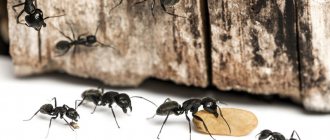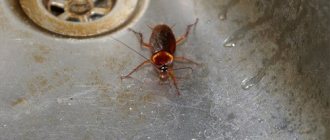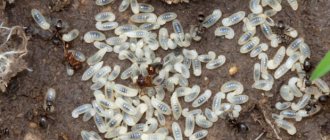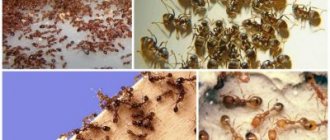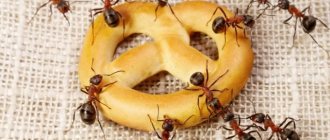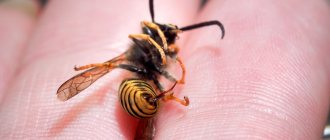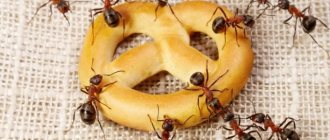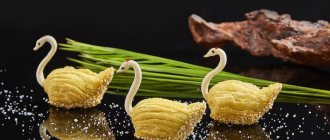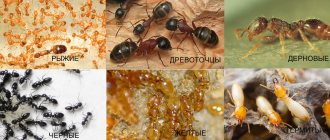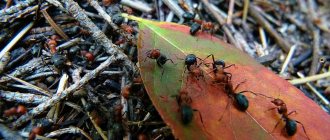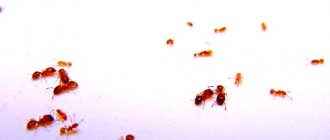The problem of getting rid of ants from ordinary apartments is quite acute for many people. In this article we will tell you how to get rid of unwanted guests, as well as how to do it forever.
Despite the fact that many people believe that ants are quite neat insects that, unlike cockroaches and other small neighbors, do not cause much discomfort at home.
However, if there are already too many of them, the fight should begin.
Remember that in any case, ants are insects that can become carriers of very unpleasant microbes and microorganisms; moreover, if there are small children, animals or allergy sufferers in the house, ants can become dangerous for them.
Find out the main causes of insects and how to remove fleas from your home.
For folk remedies for cockroaches using boric acid, read this article.
How to get rid of ants in the garden forever
Loading...
- Ash This is how my grandmother fought the ants. At dusk, when all the insects returned “home,” she took a shovel and dug up the entire anthill in two or three times. Then she quickly transferred it, along with its inhabitants, into a bucket and took it outside the site into the forest. And the hole was filled with stove ash. After this, the ants usually did not bother her until the end of the season.
- Boric acid and yeast This method helped remove ants from my dacha. It is necessary to mix a pack of boric acid and a pack of dry yeast in a jar. Dilute a little with water, add a glass of jam and water all the ants’ habitats. The very next day you will notice dead ants, the next day there will be fewer insects, and after the repeated procedure they will completely leave the area.
- Unrefined sunflower oil It is necessary to fill the ants' nests with unrefined sunflower oil. Ants are sensitive to odors and do not like the smell of oil. They say that after such treatment there are much fewer unwanted neighbors on the site, but, frankly speaking, I would rather use vegetable oil for salad.
- Semolina and soda You need to take 1 kilogram of semolina and one pack of soda. Mix everything well and fill the anthill. The only condition is that this must be done in dry and windless weather.
- Yeast and sugar Take a packet of dry yeast and about the same amount of sugar. Mix everything well and fill the anthill. According to country experts, the ants die after such a procedure.
- Ammonia Neighbors at their dacha claim that ammonia helped them get rid of ants. You just need to dilute a small pharmaceutical jar of ammonia in three liters of water and spray the places where insects accumulate, after which they will leave the area.
- Red pepper Another pack of red pepper is infused in a liter of water with the addition of 300 grams of laundry soap. The anthills are watered with this solution, after which the ants definitely leave. Checked!
- Salt Sprinkle the anthill with salt, and also scatter it along ant paths and places of greatest concentration of insects.
- Millet It is not very clear how millet helps get rid of ants in the garden, but many gardeners claim that this particular method helped them. There is a version that ants mistake millet cereals for ant eggs and deliver them to the nest.
There, the grains swell under the influence of moisture and clog the passages. The result is the death of the uterus from starvation. In practice, millet is more likely to attract birds, which can eat ants and can destroy your crop.
The main dream of a summer resident is to get a good harvest that will be stored for a long time. Trying to protect their vegetation from pests, gardeners and gardeners buy a lot of poisons. And they make a big mistake. There is an alternative - use folk remedies, such as baking soda.
Iodine saves not only broken knees, but also plants from late blight and powdery mildew, protects against root and fruit rot, nourishes seedlings and increases yield...
By planting a small bush or flowerbed in your summer cottage or near your house, you can take a break from your daily routine, and after a couple of hours in the fresh air, with renewed vigor, you can complete what you have been unable to do for so long. Who knows, maybe there is a gifted landscape designer in you.
Yeast: delicious baked goods or ant death?
Ants are amazing insects. If they have started somewhere, it is not easy to exterminate them or drive them out.
They simply ignore many insecticidal agents, quickly adapt to others, and still others turn out to be too harmful for the warm-blooded inhabitants of the house and garden.
One of the interesting folk remedies for fighting ants is ordinary yeast. We actively use them in cooking, but for insects they turned out to be a real nightmare, leading to a quick and rather painful death.
How can yeast be used to control insects, and is it dangerous to people and pets?
Operating principle
Let’s say right away that yeast is completely safe for people, and for most pets too.
Direct poisoning of ants rarely occurs, since yeast can hardly be considered an integral part of their diet.
The smell of this product is fascinating for them; pests will happily eat them right on the spot, as well as carry their prey en masse to the nest.
Over time, the yeast in the anthill will begin to ferment. This invariably leads to the fact that all other food supplies become unusable. This leaves the ants with only two options:
- look for a new place of residence;
- clean the nest (they will not be able to do this);
- die of hunger.
The last scenario is the most likely. The fact is that they will have a surplus of other products and will quickly replenish their supplies. But insects are not smart enough to understand the harmful effects of yeast on food. As a result, the colony will certainly die out, albeit rather slowly.
How to use yeast against ants in an apartment
Ants are not always willing to attack yeast in its pure form. Their appetite largely depends on the area in which they live. It is noted that this remedy produces the greatest effect in the central part of Russia, and slightly less in the north.
The southern regions cannot boast of the effectiveness of the method - the average temperature there is higher, the yeast spoils faster. Accordingly, ants are not always familiar with such a product
They will like the smell, but they will treat it with caution
Yeast against ants can be used in its pure form, but it will not be very attractive, and they will not develop a brutal appetite. The recipe is simple:
- 50-100 grams of yeast finely crumble into a bowl;
- the same amount of sugar is mixed into them;
- the mixture is poured with warm water (in no case hot, otherwise the bait will quickly become unusable).
The mass is thoroughly mixed until it becomes a porridge. Balls are molded from it, which are laid out near places where insects accumulate and pest routes.
Ants love sweets very much. Sugar mixed with wet yeast will give them a ravenous appetite. They will deliver treats to the nest in large quantities, constantly clogging their storage. The good news is that the implementation of this method does not require large financial and time expenditures.
The method is completely safe, yeast does not pollute the environment in any way. This product can be used both in a summer cottage and in an apartment. True, indoors the effect is still somewhat higher. The differences in the scale of the anthill are reflected - in nature they have several storage facilities at once.
The benefits and harms of ants in a summer cottage
If you don’t want to use chemicals like “Ant”, “Aardvark” and “Great Warrior”, you can remove pests from the garden using plants whose smell they cannot tolerate. These include:
- tomatoes;
- garlic;
- tansy;
- marigold;
- celandine;
- fragrant herbs: parsley, anise, bay leaf, tobacco, valerian, mint, mustard.
An unusual method of getting rid of uninvited guests is to introduce their forest counterparts to the pests. Disagreements will inevitably arise between them, and after some time the garden insects will die in battles with rivals from the forest, and the surviving individuals will leave the battlefield. As for wood ants that are not adapted for living in a personal plot, they will return to their natural living conditions.
The complexity of this method lies in the fact that it is necessary not only to find an anthill in the forest, but also to deliver it to the garden or country house intact. It is better to transport it with a large durable bag and a shovel
You need to act as carefully as possible, because ants can bite
You should not go for an anthill wearing sleeveless clothes and shorts. The number of forest insects should significantly exceed the number of garden insects. Place their nest in close proximity to the latter’s home
ants can bite. You should not go for an anthill wearing sleeveless clothes and shorts. The number of forest insects should significantly exceed the number of garden insects. Their nest is placed in close proximity to the latter’s home.
Relocating insects is another humane way to get rid of them. In the evening, when all the inhabitants of the anthill are assembled, you need to quickly dig it up and place it in a strong large bag or capacious bucket. After this, you need to take it as far away from the plot as possible, and upon returning, pour boiling water over the remains of the nest.
This is not the most effective method of getting rid of pests. It is better to use it for preventive purposes. To prevent ants from taking a fancy to your garden plot, you should:
- timely free it from weeds and dead plants;
- fight aphids on plants;
- do not throw apple and pear cores, seeds of sweet fruits, or berry stalks on the ground;
- harvest in a timely manner;
- Clean up the pads regularly.
Anthill
1. Fill the anthill:
- boiling water;
- kerosene;
- infusion of tomato tops;
they claim that after such a procedure, the surviving ants leave this place forever.
3. Pour a poisonous solution into the anthill:
- vegetable oil - 400 ml;
- any cheap shampoo - 400 ml;
- vinegar - 400 ml;
Pierce a hole in the center of the anthill and pour this mixture into it. Cover with film for several days.
DIY ant trap
Today there are a huge number of ant traps that you can make with your own hands. They will be very good at fighting if you know in advance all the paths and moves of these insects. In most cases, they choose the same route.
1. Prepare the room:
- Remove and pack all available products;
- It is good to wash all floors, and especially dark corners and crevices that are difficult for humans to reach;
- Waste must be immediately disposed of in general waste bins;
- The kitchen must be treated with a low-concentrated solution.
2. Processing surrounding objects using improvised means
- Ammonia or Ammonia. With a 10 percent solution, which can be found in any pharmacy, wipe all known insect paths. But ammonia is a very toxic substance, so it is necessary to ventilate the premises after using this method.
- Soda. If you repeatedly rub and then wash off thickly mixed soda, like a paste, then unfriendly guests will leave soon. The main thing is not to forget that this procedure must be repeated several times.
- A mixture of vinegar and lemon. When mixing, the main thing is to correctly determine the amount of substance to be mixed. With this solution, as in the first case, it is necessary to lubricate all possible and probable paths and roads of ants.
- Red pepper. Sprinkle the powder in places where insects appear most often. Ants have receptors that are unable to perceive spicy foods. Sensing something is wrong, they will leave their habitat.
DIY ant traps
Options for making an ant trap:
- Use tape. To do this, take a small saucer or lid and put tasty bait in the center. Cover the edges of the container with double-sided tape.
- Container with liquid. A regular glass jar will do for this. Pour water and sugar into it almost to the top and place it in places where pests are most concentrated. Once in the jar, the ants will simply drown.
- Boric acid. It must be mixed with mashed potatoes and spread indoors. After eating such a delicacy, the ants die themselves and infect other individuals.
- Vegetable oil. Coat the inside of a glass jar with oil and place a sweet treat for insects inside. Place a small twig near the container itself so that the ants can climb onto it. They will be able to crawl back out.
It is important to understand that any DIY ant trap will have a shorter service life than its store-bought counterparts. Therefore, they will have to be changed somewhat more often.
If time permits, then you can easily build an ambush with your own hands:
- Place a packet of boric acid mixed with sweet syrup into plastic lids.
- Place poisoned baits under the table, near cracks in the floor, ventilation shafts, in the pantry and other places where pests are encountered.
Trying the sweetness, worker ants infect their relatives and die themselves. All you have to do is periodically check the “ant ambush” and add poison. Uninvited residents are also repelled by the smell of mint, shag, bay leaves, wormwood, cloves and garlic. Sprinkle or lubricate strong-smelling ingredients where they accumulate.
More than once, homemade devices have proven effective and inexpensive. But if there is a child or some kind of living creature in the house (a cat, for example, or a turtle), then it is better to give preference to a purchased trap without poison.
You can build a device for fighting domestic ants with your own hands:
- Mix a bag of boric acid and a little sweet syrup, jam or honey;
- Place bait in lids or shallow plastic boxes;
- Place traps under tables, near baseboards, trash cans, closets, and other insect habitats.
Other options for homemade traps:
- Using double-sided tape. Place a little jam or honey in a plastic lid (small saucer). Cover the edges of the container with double-sided tape;
- Sweet liquid. Fill a glass jar almost to the top with water and sugar syrup and place it in places where ants accumulate. Once in the jar, the insects will simply drown;
- Vegetable oil. Coat the inside of the jar with sunflower oil and put sweet bait on the bottom. Place a stick or twig on the container so that pests can climb onto it. The ants will not be able to get out of the jar.
With the help of traps you can get rid of small pests in a week. Correct use of devices, as well as regular replacement of bait, will help to achieve maximum results.
Poison for ants at home - preparations for ants in the house
Let's start with the fact that getting rid of ants forever is a rather painstaking task, and not only poison will help here. Therefore, first of all, you need to know preventive measures. So, to prevent ants from bothering you in your house, apartment or country house, it is recommended:
- carry out wet cleaning regularly,
- wipe the dining table and floor with disinfectants,
- store sweets and fragrant foods in tightly packed containers,
- Regularly empty trash cans in your home or yard.
- Do not leave food crumbs behind.
These recommendations will not help you get rid of insects forever, but they can prevent their reproduction.
In addition, you can independently prepare poison for ants at home, using for this purpose substances at hand that are harmless to humans and pets.
How to get rid of ants in an apartment?
If insects have infested your apartment, then the most effective and harmless remedy will help you get rid of them forever - citric acid or a slice of lemon.
First you need to find the place where the insects are most concentrated. This could be a corner in the room or on the balcony. There you place the lemon cut into slices. Its smell is unpleasant to insects, and if you haven’t yet got a whole army, but only a few dozen individuals. then they will probably run away.
If you use citric acid, then you need to sprinkle powder on the areas where they accumulate. In this case, the poison will have a destructive effect, and the insect will die after tasting it.
Remedies for ants in the country
Folk remedies for insects in the countryside give excellent results if used correctly. At the dacha there is always something to eat, and this is an excellent “airfield” for insects. The best remedy is, naturally, chemical poisons specifically designed for ants in the country. They give excellent results immediately after the first application on the site. They are produced in the following forms:
• capsules, • aerosols, • liquids.
It is worth noting the most effective of them. This:
• Raid, • Clean House, • Karbofos, • Raptor, etc.
Preventive actions
The main rule of prevention is cleanliness in the house. Take out the trash, do not leave pet food in the bowl for a long time, and remove crumbs from the table and floor. Store sugar and cereals in glass jars or plastic containers that are tightly closed. Insects will not settle where there is nothing for them to eat. Once a month, wet clean the floor with ammonia added to the water; its smell will repel ants.
There are several ways to repel ants: The smell of garlic, lubricate the paths with a clove of garlic. The smell of lemon, parsley, mint, anise, cloves, bay leaf and tobacco will also scare them away. Soap solution - dilute water with soap, add anise or mint oil. This solution will destroy the paths and drive away the ants. If nothing works or you are too lazy to do it yourself, call a pest control service. Take your choice seriously, the effectiveness of this event depends on it. And remember, a good company will always guarantee free re-processing.
Conclusions from Tikhon: Ants in an apartment are not a death sentence, but a temporary inconvenience. You need to approach the problem individually in each case; all the means and methods described above will help in exterminating insects. And remember it is always easier to prevent than to fight.
Happiness to you and your home.
Fighting garden ants, methods, means
Ants are a group of arthropod insects that are divided into 12 subfamilies, 297 genera, and approximately 8,800 species.
Ants have highly developed intelligence and live in colonies of up to 10 million individuals. By the way, only ants (with the exception of humans) wage organized wars and capture prisoners, turning them into their slaves.
So let’s take a closer look at the question: Fighting garden ants
Ants can be found everywhere, with the exception of territories located beyond the Arctic Circle. Ants live both on the ground and in trees, forming colonies-anthills, where they reproduce.
In each colony there is a queen that lays eggs from which young ants are born. Ants feed on other insects, hunting them and collecting their corpses, as well as plant sap, mushrooms and leaves.
The average lifespan of an ant is 1 year.
On the DIY Garden website, in addition to this material, you will find a lot of other useful information.
Damage caused by garden ants
Unfortunately, garden ants are not a blessing (as is usually believed), but a real evil, so the fight against garden ants in the garden is ongoing and there are good reasons for this.
The most important reason for controlling garden ants is aphids. Or rather, herds of aphids that are bred and grazed by garden ants on the tops of young shoots. But aphids are one of the most dangerous garden pests, especially for fruit and berry crops (apple, pear, plum, currant, ...).
And if decorative seedlings after this “simply” lose their decorative properties (the leaves curl, the shoots become bent, and if they are heavily infected, they stop further growth), then the result of the invasion of garden ants on a bush, for example, black currant, can be an almost complete lack of harvest.
And although there are many effective means of combating aphids, this is useless if there are garden ants on the site.
As soon as the plant, treated and cleared of aphids, came to life and began to gain strength, the ants are right there again with their “herd” - and everything starts all over again.
Therefore, in this situation, it is necessary to talk not about the fight against aphids, but about the fight against garden ants and the complete destruction of ants, because they are the main culprits of your lost crop.
the anthill grows not only upward, but also deeper, reaching 1.5 or even more meters and will grow every day.
There are other reasons why exterminating ants becomes a vital activity, but the main question is not: “why do you need to fight ants,” but “how to quickly and effectively destroy ants”? But here the answer is not so simple...
Destruction of ants with folk remedies
Many improvised means that are almost always available in everyday life are effective in combating ants in garden beds. Popular experience recommends using the following means:
Boron or powdered boric acid
It can be used to fill ant nests, but it is more effective when used as part of a sweet bait - ants love sweets. To prepare the bait, you need to mix boron with syrup, jam or sugar and water. Dosage – approximately 5 g per 100 ml of sweet base.
This poison is very effective, since the ants do not die from it immediately, but still have time to return to the anthill and feed the larvae and the queen there. The bait is laid out in a low dish next to ant nests or on their paths; it needs to be changed every 3-5 days. In about 2-3 weeks, the entire colony of insects will die out.
A mixture of crushed hot pepper and dry mustard
Sprinkle the mixture between the rows of plants in continuous strips 5 cm wide. Pepper and mustard not only repel insects with their smell, but also corrode their chitinous layer upon direct contact. This method is safe for plants and soil. If you only have pepper or mustard on your farm, it doesn’t matter, they are also effective individually.
Soda
You need to thoroughly fill the entire nest with soda powder, especially the entrance holes. Insects will die from contact with the powder. Soda will not harm the soil, on the contrary: if the soil is alkaline, soda will make it neutral or slightly acidic. Soda can also be used in a mixture with dry mustard.
Boiling water
You need to pour it directly into the nests, only carefully so as not to damage the nearby plants. This method is effective, but it is not suitable if the nest is located under the roots of a tree or shrub.
Fire and flammable mixtures
It is better to dig up the upper part of the nest to expose the internal passages. Pour a flammable mixture (gasoline, kerosene) into the passages and set it on fire. It is better to do this in the evening and at night, when all the ants are resting in their nest.
Burning out an ant nest is very effective, but this method can be used either in the spring, when the beds are not yet planted, or in the fall, when the harvest has already been harvested. In summer, instead of burning, you can use ash - tear up the upper part of the anthill and fill it with hot ash.
Vegetable oil
Water the anthill and the paths along which insects move with it. Once soiled with oil, insects are unable to cleanse themselves from it. The oil film prevents them from breathing, so they quickly die. And the smell of oil itself is also unpleasant for ants.
Urine
Some gardeners advise filling ant nests with urine. Judging by numerous reviews, the method works quite well. The ants probably cannot stand the smell and composition of urine.
Quicklime
It is poured into an ant's nest and filled with water. This method quickly kills insects, but it is dangerous to use near cultivated plants and trees - you can damage the roots. If the nest is not located in the garden bed, but somewhere near the plantings, then you can safely use lime.
Salt
Salt helps in the fight against ants, but it must be used very carefully and precisely. Salt remains in the soil for a long time, and its presence is extremely undesirable for plants. If you overdo it with salt, you can be left without a harvest for several years.
Yeast
Yeast can be poured into an anthill in dry form, but it is better to first pour it with a sweet solution (water and sugar). Gardeners justify the effectiveness of this method by the fact that yeast bacteria are quickly activated and spread to the food supplies of ants, which they store in underground burrows.
Ants collect mainly sweet organic matter in the garden, which yeast bacteria are very fond of. When the yeast begins to destroy the ants' reserves, they leave their nest in panic in search of a more suitable place.
Sulfur and oregano
Mix sulfur with dried oregano in a 1:2 ratio, fill the anthill and dig it up with soil. This good repellent will force the surviving ants to move far from the garden.
A mixture of kerosene and water
Water and kerosene are mixed 1:1, the composition is poured into the nests. Before this, it is better to stir up the anthill so that the solution gets into the internal chambers with the larvae and the queen.
A mixture of water, vinegar, shampoo and vegetable oil
This method is more suitable for getting rid of insect nests outside the beds. Take 10 liters of water into a bucket, pour in a bottle of vinegar, 2 cups of vegetable oil and a bottle of any cheap shampoo. Mix everything well and pour into the ant holes. At the site of the intended nest, it is better to make deep holes with a peg and carefully pour the solution into them. After this, cover the treated area with film for 3 days - the insects will die out.
How to get rid of ants in the garden using ammonia
Insects spread aphids to all young plants, resulting in their death. You can fight them with ammonia. Better known as ammonia, which has an unpleasant and pungent odor.
We need to find the ants' home, gut it and fill it with ammonia. For a small nest, it will be enough to dilute 50 ml of ammonia in 1 liter of water.
The next day, you will not find ants in the watering area. Some of them will die from the pungent odor, and the rest will leave their permanent location.
The video explains this method in detail:
Application of pesticides
The use of pesticides is an extreme measure, justified only in cases where no means have helped, and the plants on the site are in a catastrophic condition.
A Greensad specialist talks about the use of insecticides against ants:
Please note! The effect of poisons cannot remain without consequences: while destroying ants, the poison simultaneously destroys all other insects, including beneficial ones.
Insecticidal gels
An insecticide quite popular among private homeowners and summer residents. It is effective and its effect lasts for a month.
In the video, Vyacheslav Aleksandrovich shows where and how such a gel is used. "Clean House" in action.
Effective recipes
Ants are very fond of sweets, so they willingly damage flower beds in the garden, eating away the contents of the buds. In the garden, they are not averse to eating berries, sweet vegetables and root vegetables. By the way, it is ant colonies that provoke the appearance of aphids for the nectar they produce.
The following recipes using yeast will help you get rid of these garden pests:
- Yeast with sugar is the simplest, and therefore the most popular, remedy for ants. Yeast powder is mixed with granulated sugar in a ratio of approximately 1:1, poured into a saucer and placed in an area where insects are concentrated.
- Yeast with syrup. Add 5-6 tablespoons of sugar to a liter of water, then dissolve it in a water bath. After cooling the resulting syrup, add the dry yeast product into it. The mixture is used in a liquid state, poured into saucers and placed where the ants follow, or the ingredients are mixed into a thick paste, from which small balls are then rolled and laid out on the site.
The syrup must be cold or cool, otherwise the yeast will die from the high temperature and will be useless.
- Jam and yeast are an insidious and effective combination against ants, because these insects are partial to sweet fruits. Raspberry, currant and strawberry jam have proven themselves better than others. The recipe is simple: you need to mix one ingredient with another in equal proportions and place it in bowls in problem areas in the country house or apartment.
- Honey and yeast are mixed using a special technology to prepare a remedy for ants. The pressed product is first crushed and dissolved in cold water or, better, in milk, and only then added to honey, mixing thoroughly.
It is recommended to use honey bait in the house, since in a summer cottage it can attract other insects (bees, wasps, flies, bumblebees).
Yeast and boric acid help fight large ant colonies. The mixture is prepared from equal proportions of the components. You can add any other ingredients from the recipes listed above to it. Boric acid causes paralysis of the insect, as a result of which it dies. It is not recommended to increase the dosage of boric acid to enhance the effect. In this case, the infected individual will face instant death, and it is necessary to ensure that its relatives are infected.
If there are too many insect nests on the site, and their families are large, the following advice will help. As a complement to sweet baits, dry crushed yeast should be sprinkled directly onto anthills and along the paths of insects. This will increase the chance that particles of yeast products will fall into the deep chambers of the ants' lair, contaminating their supplies.
Boric acid
Ants produce acid themselves, so they cannot tolerate the presence of any other acid nearby.
Anthills are watered with a diluted solution of acetic or citric acid; hydrochloric and sulfuric acid are also used, but with great care. Very soon after such manipulations, the ants leave this place
Boric acid is perhaps the most well-known method of getting rid of garden ants on a site. Prepare sweet baits with boric acid and place them next to the anthills.
Recipe:
2 tbsp. spoons of warm water are poured into a glass, add 13 teaspoons of boric acid (sold in a pharmacy and costs a penny) and 1 tbsp. spoon of sugar. Mix well. You can also add 1 teaspoon of honey or sweet jam. Pour the solution into a saucer and place it near the anthills. After a few days, you need to prepare a new composition, because it gradually loses its strength.
Boric acid acts on ants in this way:
Ants do not die immediately from the product, but after 4-5 days. But during this time they manage to drag the dangerous bait into the anthill, feed the larvae and the queen. They die. There is no one to care for the eggs, and the entire colony dies.
It is not recommended to increase the dose of boric acid in the hope that this will enhance the effect. You should not do this, because the ants will die immediately, without having time to infect others.
How to get rid of ants in the countryside
So, if you find an ant nest in your garden or vegetable garden, you will have to take comprehensive action. Be prepared that the fight against ants will be long. First, dig the anthill quite deeply.
Then add ash, mustard powder or lime to the ground and dig again. Most likely, this way you will be able to drive the ants out of the area - alas, only from a specific, local one.
Surely these insects will move a little further and continue their life activity in your garden.
You can destroy ants in your garden only by consistently fighting them. Look for new anthills and treat them with a solution of ash, baking soda, boric acid with granulated sugar, and a decoction of tomato tops. Dig up the soil and add sulfur mixed with oregano. Water the paths along which the ants move with vegetable oil.
Surprisingly, ordinary millet or semolina can scare away ants. Sprinkle the cereal on the ant nest and the insects will go away. Why this happens is unknown, but the method works. You just need to take care that the semolina or millet is not eaten by birds. To do this, you can cover them with mowed grass.
Methods using various types of bait are also quite effective. You can dilute yeast in water (to get the consistency of sour cream), add jam or honey, apply the mixture to cardboard or plastic and spread it around the garden. The ants will eat the bait and die.
While it is not possible to remove ants from the site, you definitely need to take care of the trees. They suffer greatly from aphids, whose sweet secretions the ants feed on.
You can also wrap trees and shrubs in a foil skirt, leaving a sharp edge protruding from the trunk.
Ants also cannot stand the smell of garlic, lavender, lemon balm, dill, mint, and cilantro. Plant as many of these plants as possible throughout the area, this way you can at least partially protect the beds from ants.
What to do if bitten by an ant?
If you are bitten by an ant, the sensation is unpleasant and that is why it is so important to know what to do in this case. As a rule, there is slight redness at the site of the bite and itching, swelling goes away after a few hours on its own. But it’s much worse if you are allergic to an ant bite:
But it’s much worse if you are allergic to an ant bite:
- Swelling at the site of the bite and a blister pops up, causing an unpleasant itch.
- Extensive redness of the dermis and increased pain develop.
- I am worried about nausea and attacks of dizziness and fainting.
In this case, you should immediately take a number of measures:
- Treat the bite site with alcohol or vodka.
- To relieve itching, apply a paste of baking soda diluted with water to the bite site.
- To relieve redness and increased body temperature at the site of the bite, apply a fresh slice of potato.
- You should definitely take an antihistamine and then go to the hospital.
Good to know! To successfully fight ants in your own garden or on a personal plot or flower bed, it is important to first eliminate the cause of the appearance of insects, and only then drive them away. Not only timely prevention and effective methods and means will help with this, but also our advice
Yeast: delicious baked goods or ant death?
Ants are amazing insects. If they have started somewhere, it is not easy to exterminate them or drive them out.
They simply ignore many insecticidal agents, quickly adapt to others, and still others turn out to be too harmful for the warm-blooded inhabitants of the house and garden.
One of the interesting folk remedies for fighting ants is ordinary yeast. We actively use them in cooking, but for insects they turned out to be a real nightmare, leading to a quick and rather painful death.
How can yeast be used to control insects, and is it dangerous to people and pets?
Operating principle
Let’s say right away that yeast is completely safe for people, and for most pets too.
Direct poisoning of ants rarely occurs, since yeast can hardly be considered an integral part of their diet.
The smell of this product is fascinating for them; pests will happily eat them right on the spot, as well as carry their prey en masse to the nest.
Over time, the yeast in the anthill will begin to ferment. This invariably leads to the fact that all other food supplies become unusable. This leaves the ants with only two options:
- look for a new place of residence;
- clean the nest (they will not be able to do this);
- die of hunger.
The last scenario is the most likely. The fact is that they will have a surplus of other products and will quickly replenish their supplies. But insects are not smart enough to understand the harmful effects of yeast on food. As a result, the colony will certainly die out, albeit rather slowly.
How to use yeast against ants in an apartment
Ants are not always willing to attack yeast in its pure form. Their appetite largely depends on the area in which they live. It is noted that this remedy produces the greatest effect in the central part of Russia, and slightly less in the north.
The southern regions cannot boast of the effectiveness of the method - the average temperature there is higher, the yeast spoils faster. Accordingly, ants are not always familiar with such a product
They will like the smell, but they will treat it with caution
Yeast against ants can be used in its pure form, but it will not be very attractive, and they will not develop a brutal appetite. The recipe is simple:
- 50-100 grams of yeast finely crumble into a bowl;
- the same amount of sugar is mixed into them;
- the mixture is poured with warm water (in no case hot, otherwise the bait will quickly become unusable).
The mass is thoroughly mixed until it becomes a porridge. Balls are molded from it, which are laid out near places where insects accumulate and pest routes.
Ants love sweets very much. Sugar mixed with wet yeast will give them a ravenous appetite. They will deliver treats to the nest in large quantities, constantly clogging their storage. The good news is that the implementation of this method does not require large financial and time expenditures.
The method is completely safe, yeast does not pollute the environment in any way. This product can be used both in a summer cottage and in an apartment. True, indoors the effect is still somewhat higher. The differences in the scale of the anthill are reflected - in nature they have several storage facilities at once.
Reviews
I didn’t want to poison my house with insecticides, so I decided to try the folk method of fighting ants. The choice fell on yeast because of its cheapness and safety. I don’t know whether the ants left or died out, but the result was positive - after a month there were no ants in my house. I prefer to attribute the rare corpses of insects to the fact that famine broke out in the anthill.
Mark, Moscow
I'm tired of the ants! They were everywhere, eating my food and even crawling on me sometimes. I didn’t want to spend money on expensive products, so I decided to try yeast. A good folk remedy, I tell you. Half the colony died out, the other half left. Everything took three weeks. Yeast does not provide prevention; I caught several insects two months after treating the apartment. Repeated use of the product helped. I recommend!
Inna, Totma
At the dacha, the ants did not leave, although they carried probably kilograms of yeast home. But everything was fine in the apartment - within a month the colony died out. There were a lot of corpses. I don’t know how yeast acts on their body, but for people this remedy is definitely harmless.
Dmitry, Volgograd
Causes and consequences of ants appearing on strawberries
Establishing the reasons for their appearance in the beds will help save strawberries from ants. This garden crop by itself is not capable of attracting ants, but they will not refuse to feast on it. Probably, insects already lived in the places chosen for the strawberry plantation. It is known that in the course of their life, ants significantly improve the quality of the soil:
- loosen, ensuring a flow of oxygen to the roots;
- increase the concentration of microelements (potassium, manganese, phosphorus), thereby increasing productivity many times over;
- stimulate the growth of beneficial microorganisms;
- destroy eggs, larvae and mature individuals of harmful insects.
It is not surprising that after some time the gardener chooses this area for strawberry beds. And ants act indiscriminately. They begin to eat ripening berries and spoil the thin roots of plants. They bring entire colonies of aphids to the soil surface, which serve as a source of food for them. Soon, brown spots form on the dark green leaves, and putrefactive processes develop on the roots. This is how aphids become involved in damaging garden crops.
We also recommend watching:
- Gooseberry pests - who can eat all the leaves - sawfly in the caterpillar stage
This article took a long time to write, and I haven’t returned to it even once. Gooseberry pests in the garden - what are they? The list could go on for a long time - there are probably a lot of them......
- Growing black currants in Kuban, care problems, pests, diseases
A tasty and healthy berry is black currant. Growing it in Kuban has its own characteristics, because getting a full harvest of black currants is not so easy in our country. Hot,…
- Strawberries, cultivation and care in open ground, pests and diseases
What berry does almost every gardener have? Of course it's strawberry. Growing and caring for them in the open ground brings joy, worries and, alas, grief. Lots of questions...
- Planting carrots in spring in open ground: timing, care, pests
For me, planting carrots in open ground in the spring is preparation for the arrival of my granddaughter. She really likes to “crunch” her right at the dacha. Since the plot for this…
- Gall midge on raspberries, what to do
Have you noticed strange growths and bumps on the raspberry stems? Please know that the gall midge on raspberries is a very dangerous pest that can significantly reduce yields and sometimes completely destroy...
- Ash as a fertilizer - benefits, composition, use in the garden
Ash as a fertilizer, and a very valuable one at that, has been recognized for a long time. Many generations of gardeners use it to increase soil fertility. It contains most of the main…
